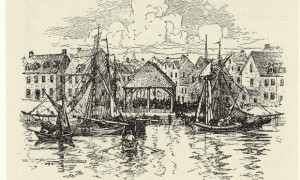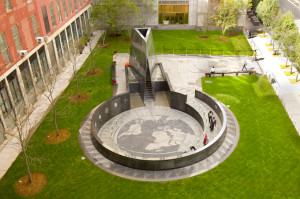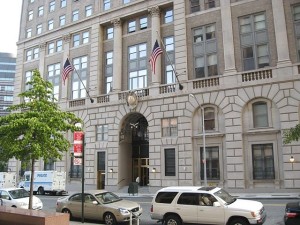Martin Luther King Jr. Day commemorates the life of Dr. King and the work of the African-American civil rights movement in the United States. As one of the oldest cities in America, New York City has been a location for many significant milestones of African-American history, for better and for worse. In celebration of the holiday, we have created a list of historic places that have a connection to the civil rights community. Some of these site have even been designated national landmarks.

Sketch of the New York City Slave Market. Image credit: New York Public Library
Slave Market Historical Marker
Location: Northeast corner, Wall and Water Streets, Manhattan
Date: 1711-1762
New York City has been a hub for international trade since its founding days as a Dutch colony, and the African slave trade was no exception. Records of African slaves bought and sold in New York City date as early as 1626, and from 1711 until 1762 a market exclusively for buying, selling, and renting slaves operated at the corner of Wall and Water Streets. At the time, the intersection was on the banks of the East River and the publicly-operated market had its own pier for slave ships from Africa and the Caribbean to dock and offload its human cargo directly into the market. The market was torn down in 1762 amid complaints from residents that the market was blocking river views and depressing property values. On June 27, 2015 Mayor Bill de Blasio and Councilmember Jumaane Williams commemorated placing a Historical Marker at the intersection in acknowledgement of this period of City history.
African Burial Ground National Monument

The African Burial Ground Monument. Image credit: National Parks Service
Location: 290 Broadway, Manhattan
Date: 1712-1794
After the establishment of Trinity Church in 1697, the church’s leaders bought up property in lower Manhattan, including the public burial ground. The ground was open to burial of anyone for a fee, including enslaved Africans. After buying the ground, the Church adopted a resolution prohibiting any Africans – freed or enslaved – from burial on their land. A new burial ground for Africans was established outside the city limits and was first recorded in use in 1712. The ground remained in use until 1794 when it was closed by the City and built over. In 1991, excavation of the ground for constructing the Federal Building at 290 Broadway revealed the burial site. After lobbying and protest by the African-American community, Congress adopted a law in 1992 to redesign the Federal Building allowing for a memorial. The monument was dedicated in 2007 after archaeological studies were completed.
Location: 265 Henry Street, Manhattan
Date: 1893
Established in 1893 as a social service center for the poor, the Henry Street Settlement was the site of the Niagara Movement’s conference in 1909, called in response to the 1908 Springfield (IL) Race Riot. From that conference, a separate group called the National Negro Committee was established, joining early African-American civil rights leaders Ida B. Wells and W.E.B. DuBois with Mary White Ovington, William English Walling, and other white progressives to address civil and political injustices against African-Americans. The Committee would reconvene one year later at the Charity Organization Hall in Manhattan’s Lower East Side and formally adopt the name “National Association for the Advancement of Colored Peoples”, or NAACP. The NAACP would go on to fight for desegregation, famously winning the Brown v. Board of Education Supreme Court case.
March On Washington organization headquarters
Location: West 130th Street and Lenox Avenue, Manhattan
Date: 1963
The March on Washington for Jobs and Freedom was a signal event in Dr. King’s civil rights activism, gathering 250,000 people on the Mall in Washington D.C. where he delivered his “I Have A Dream” speech. Planning and organization for the event was done here at a Harlem brownstone and managed by Bayard Rustin, a longtime activist who organized the first Freedom Rides across the South. Two hundred activists and organizers were recruited and trained at the headquarters, along with 4,000 volunteer marshals to organize the march when in Washington. The headquarters oversaw fundraising for the march and successfully dispatched 450 busloads of protesters from Harlem to Washington.

110 Livingston Street. Image credit: Jim Henderson
Former Board of Education Headquarters
Location: 110 Livingston Street, Brooklyn
Date: 1926
Originally built as a headquarters for the Elks Lodge, 110 Livingston Street was the headquarters for the New York City Board of Education from 1940 until 2003. On February 3, 1964 teachers, parents, students, and activists led a march across the Brooklyn Bridge to BOE Headquarters protesting de facto segregation in the City public school system. The march was part of a citywide one-day boycott of the City schools, organized by Bayard Rustin. The boycott involved 464,000 schoolchildren, nearly half of all children in City public schools, and thousands of other demonstrators in one of the largest protests of the civil rights era.
By: Brian Kaszuba, CityLand Editor and Michael Twomey, CityLand Fellow.

